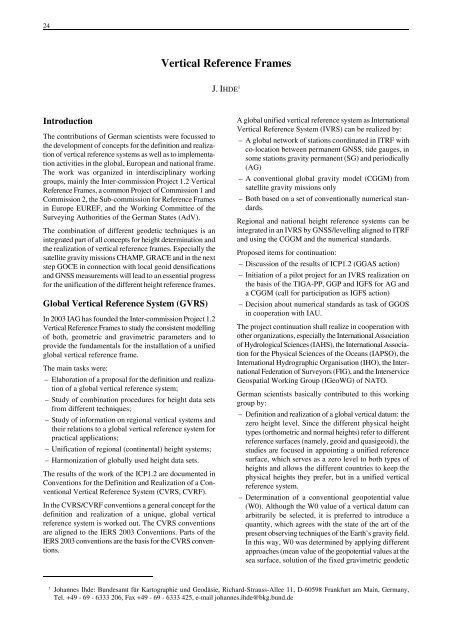NATIONAL REPORT OF THE FEDERAL REPUBLIC OF ... - IAG Office
NATIONAL REPORT OF THE FEDERAL REPUBLIC OF ... - IAG Office
NATIONAL REPORT OF THE FEDERAL REPUBLIC OF ... - IAG Office
Create successful ePaper yourself
Turn your PDF publications into a flip-book with our unique Google optimized e-Paper software.
24<br />
Introduction<br />
The contributions of German scientists were focussed to<br />
the development of concepts for the definition and realization<br />
of vertical reference systems as well as to implementation<br />
activities in the global, European and national frame.<br />
The work was organized in interdisciplinary working<br />
groups, mainly the Inter-commission Project 1.2 Vertical<br />
Reference Frames, a common Project of Commission 1 and<br />
Commission 2, the Sub-commission for Reference Frames<br />
in Europe EUREF, and the Working Committee of the<br />
Surveying Authorities of the German States (AdV).<br />
The combination of different geodetic techniques is an<br />
integrated part of all concepts for height determination and<br />
the realization of vertical reference frames. Especially the<br />
satellite gravity missions CHAMP, GRACE and in the next<br />
step GOCE in connection with local geoid densifications<br />
and GNSS measurements will lead to an essential progress<br />
for the unification of the different height reference frames.<br />
Global Vertical Reference System (GVRS)<br />
In 2003 <strong>IAG</strong> has founded the Inter-commission Project 1.2<br />
Vertical Reference Frames to study the consistent modelling<br />
of both, geometric and gravimetric parameters and to<br />
provide the fundamentals for the installation of a unified<br />
global vertical reference frame.<br />
The main tasks were:<br />
– Elaboration of a proposal for the definition and realization<br />
of a global vertical reference system;<br />
– Study of combination procedures for height data sets<br />
from different techniques;<br />
– Study of information on regional vertical systems and<br />
their relations to a global vertical reference system for<br />
practical applications;<br />
– Unification of regional (continental) height systems;<br />
– Harmonization of globally used height data sets.<br />
The results of the work of the ICP1.2 are documented in<br />
Conventions for the Definition and Realization of a Conventional<br />
Vertical Reference System (CVRS, CVRF).<br />
In the CVRS/CVRF conventions a general concept for the<br />
definition and realization of a unique, global vertical<br />
reference system is worked out. The CVRS conventions<br />
are aligned to the IERS 2003 Conventions. Parts of the<br />
IERS 2003 conventions are the basis for the CVRS conventions.<br />
Vertical Reference Frames<br />
J. IHDE 1<br />
A global unified vertical reference system as International<br />
Vertical Reference System (IVRS) can be realized by:<br />
– A global network of stations coordinated in ITRF with<br />
co-location between permanent GNSS, tide gauges, in<br />
some stations gravity permanent (SG) and periodically<br />
(AG)<br />
– A conventional global gravity model (CGGM) from<br />
satellite gravity missions only<br />
– Both based on a set of conventionally numerical standards.<br />
Regional and national height reference systems can be<br />
integrated in an IVRS by GNSS/levelling aligned to ITRF<br />
and using the CGGM and the numerical standards.<br />
Proposed items for continuation:<br />
– Discussion of the results of ICP1.2 (GGAS action)<br />
– Initiation of a pilot project for an IVRS realization on<br />
the basis of the TIGA-PP, GGP and IGFS for AG and<br />
a CGGM (call for participation as IGFS action)<br />
– Decision about numerical standards as task of GGOS<br />
in cooperation with IAU.<br />
The project continuation shall realize in cooperation with<br />
other organizations, especially the International Association<br />
of Hydrological Sciences (IAHS), the International Association<br />
for the Physical Sciences of the Oceans (IAPSO), the<br />
International Hydrographic Organisation (IHO), the International<br />
Federation of Surveyors (FIG), and the Interservice<br />
Geospatial Working Group (IGeoWG) of NATO.<br />
German scientists basically contributed to this working<br />
group by:<br />
– Definition and realization of a global vertical datum: the<br />
zero height level. Since the different physical height<br />
types (orthometric and normal heights) refer to different<br />
reference surfaces (namely, geoid and quasigeoid), the<br />
studies are focused in appointing a unified reference<br />
surface, which serves as a zero level to both types of<br />
heights and allows the different countries to keep the<br />
physical heights they prefer, but in a unified vertical<br />
reference system.<br />
– Determination of a conventional geopotential value<br />
(W0). Although the W0 value of a vertical datum can<br />
arbitrarily be selected, it is preferred to introduce a<br />
quantity, which agrees with the state of the art of the<br />
present observing techniques of the Earth’s gravity field.<br />
In this way, W0 was determined by applying different<br />
approaches (mean value of the geopotential values at the<br />
sea surface, solution of the fixed gravimetric geodetic<br />
1 Johannes Ihde: Bundesamt für Kartographie und Geodäsie, Richard-Strauss-Allee 11, D-60598 Frankfurt am Main, Germany,<br />
Tel. +49 - 69 - 6333 206, Fax +49 - 69 - 6333 425, e-mail johannes.ihde@bkg.bund.de











